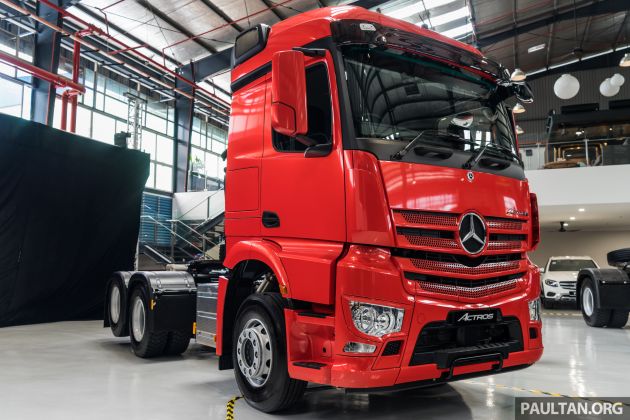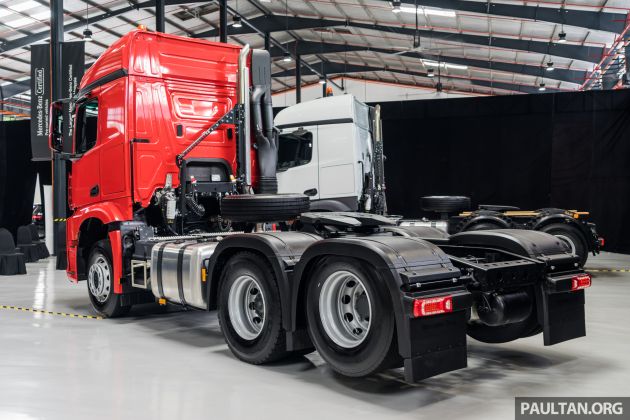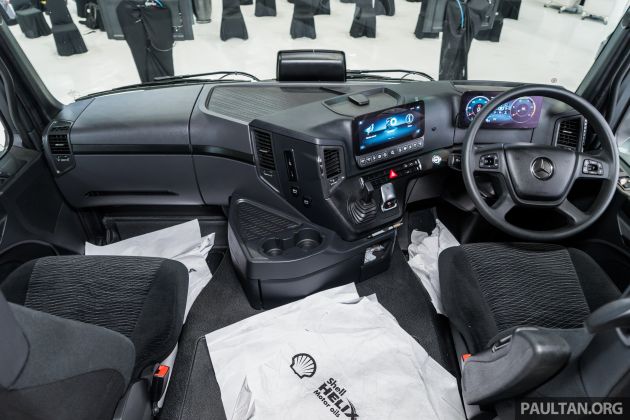Daimler Trucks distributor Hap Seng Trucks Distribution (HSTD) has just launched the new Mercedes-Benz Actros in Malaysia. The fifth-generation prime mover introduces several new features that owners of Stuttgart’s passenger cars will be familiar with.
The local lineup consists of ten CKD locally-assembled variants, including 4×2, 6×2 and 6×4 drivetrains and three cab sizes – M-Cab and L-Cab ClassicSpace and L-Cab StreamSpace. In Malaysia, the Actros is powered by a 12.8 litre OM460 turbodiesel straight-six, which in this market is Euro 3-compatible and features direct injection via a unit pump system rather than the more modern common-rail setup.
This means that the Actros will be able to run B20 biodiesel (slated to be rolled out across Malaysia by June 2021) without any modifications. Depending on the variant, power output is rated at 360 PS, 394 PS, 421 PS, 449 PS or 476 PS, made at 1,600 rpm. Peak torque, on the other hand, is either 1,800 Nm, 1,900 Nm, 2,100 Nm, 2,200 Nm or 2,300 Nm, produced at 1,100 rpm.
Mated to this engine is the new PowerShift 3 gearbox. No, it’s not Ford’s dual-clutch transmission of the same name, but a single-clutch automated manual with 12 forward speeds and four reverse speeds. A more robust double-plate clutch is fitted to the 6×4 variant for better performance with higher payloads and in severe stop-start driving conditions.
Just like on a “normal” Mercedes, the gear selector is now located on the steering column rather than on the centre console. The Actros is available with Standard, Economy, Power and Manual drive modes – in the last mode, drivers can row through the gears by either pushing or pulling the stalk.
Together with the aerodynamic improvements, which include concave side deflectors and taller doors, these changes result in a claimed four-percent reduction in fuel consumption. One new aero feature, the MirrorCam side-view cameras, have yet to be introduced here due to issues with homologation and Road Transport Department (JPJ) regulations, but HSTD states that it hopes to fit the system as standard in the near future.
At the back, the Actros has two variants of rear axles – a hypoid axle with a maximum gross combination weight (GCW) of 68 tonnes and a planetary axle with a 120-tonne GCW limit. These figures represent increases of eight and a whopping 20 tonnes respectively compared to the previous model.
In terms of in-car (sorry, lorry) entertainment, the Actros is available with the optional Multimedia Cockpit, a derivative of the Mercedes-Benz User Experience (MBUX) found in the passenger cars. It comes with the same 10-inch infotainment and instrument displays and a similar touchscreen interface, plus twin USB-C ports and Apple CarPlay and Android Auto compatibility. A regular Bluetooth-enabled head unit comes as standard, as do analogue dials with a central colour multi-info display.
Safety is another area where the Actros is much improved. Selected models come with stability control and autonomous emergency braking (with pedestrian detection) as standard, while adaptive cruise control, lane keeping assist and a driver attention monitor can be found on the options list.
Elsewhere, the Actros is fitted with halogen headlights, LED daytime running lights, full-LED tail lights and a glitzy illuminated three-pointed star at the front of this enormous lorry. It also comes with a new remote central locking system (utilising the same key as the passenger cars), push-button start, an electronic parking brake and air suspension on the driver’s seat. There’s also a reclinable “luxury bed” (with hidden storage accessible from the outside) and rear-axle air suspension depending on the variant.
Pricing for the new Mercedes-Benz Actros ranges from around RM360,000 to RM470,000 for the tractor unit alone (i.e. without the trailer), depending on the variant and subsidies offered by the government for certain industries. The lorry has a service interval of 55,000 km and a three-year/450,000 km warranty – a significant upgrade from the previous two-year/200,000 km coverage.
Source: Read Full Article



